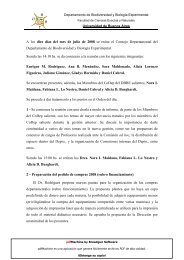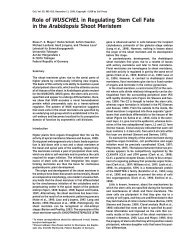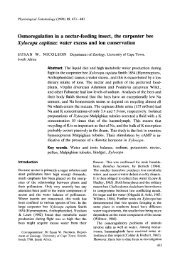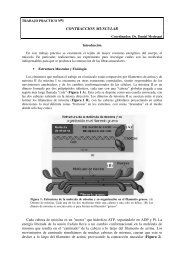The Aerobiology Pathway
The Aerobiology Pathway
The Aerobiology Pathway
You also want an ePaper? Increase the reach of your titles
YUMPU automatically turns print PDFs into web optimized ePapers that Google loves.
immuno-systems, due to disease, immunosuppressive drugs or radiation therapy, allowing<br />
the fungus to become invasive.<br />
Legionnaire’s disease is caused by the bacterium Legionella, which occurs naturally in<br />
fresh water bodies such as rivers and lakes (Postgate, 1986). However, infection of the<br />
lungs, leading to serious illness, occurs if the bacterium becomes suspended in aerosol<br />
and is inhaled. While this is rare in natural systems, aerosols in buildings produced from<br />
poorly maintained cooling systems or showers pose a serious health hazard. With their<br />
growing popularity, poorly maintained spa pools are an increasing source of this respiratory<br />
pathogen. It is likely that the original outbreak of this disease in Philadelphia in<br />
1976 was caused by infected water in the air-conditioning system resulting in an aerosol<br />
containing Legionella being blown into the conference hall. Other bacterial diseases that<br />
may be dispersed by air include Bordetella pertussis (whooping cough), Streptococcus species<br />
(causing sore throats, tonsillitis and pneumonia) and Mycobacterium tuberculosis<br />
(tuberculosis). <strong>The</strong> disease Q fever, caused by the bacterium Coxiella burnetii, is an<br />
example of a zoonotic disease spread from animals to humans via the aerobiological<br />
pathway. Infection can be spread from direct contact with animals or with infected bedding<br />
straw. This was thought to be the source of a recent cluster of infections in Wales<br />
(van Woerden et al., 2004).<br />
Many of the most harmful diseases, and often the most difficult to treat, are caused by<br />
viruses. Those for which inhalation is a potential route of infection include the common<br />
cold, mumps and influenza. Animal reservoirs represent a potential source and means of<br />
spread, as shown by the outbreak of the H5N1 strain of avian ‘flu in the Far East (Chen<br />
et al., 2004; Guan et al, 2004), while person to person spread via aerosol and droplets<br />
was an important factor in the newly emergent viral infection severe acute respiratory<br />
syndrome (SARS) (Yu et al., 2004; Wang et al., 2005). Foot and mouth disease virus,<br />
although not a serious human pathogen, can cause heavy economic losses through<br />
livestock infection and the disease agent is readily disseminated over long distances via<br />
the airborne route (Donaldson and Alexandersen, 2002; Gloster et al., 2005).<br />
5.2.7. Aerobiological hazards in natural environments<br />
<strong>The</strong> impact of Pteridophyte spores inhaled in quantity constituting a heath hazard has<br />
been investigated by Siman (1999). Bracken (Pteridium aquilinum, Pl. 7.6) is a fern that<br />
occurs worldwide. It reproduces vegetatively but also produces a large number of spores<br />
which Evans (1987) demonstrated could be carcinogenic to mice. A ten-year study of the<br />
incidence of airborne bracken spores on an urban roof in South-east Scotland showed<br />
that they are widely present in the air (Caulton et al., 1999). A Burkard trap monitored<br />
the production of spores from a small stand of bracken at Rothamsted Research from<br />
August to October in 1990 and 1991. <strong>The</strong> daily average spore content often exceeded<br />
750 spores m –3 , with a maximum of 1,750 spores m –3 . <strong>The</strong> spore release showed a marked<br />
periodicity with most being released between 0900 and 1000 GMT (Lacey, M. and<br />
McCartney, 1994). With the large area of bracken in the UK and other countries there is<br />
potential for vast numbers of airborne spores to be present in the air and the carcinogenic<br />
properties of which cause concern to rural workers and visitors to the countryside.<br />
30 THE AIR SPORA


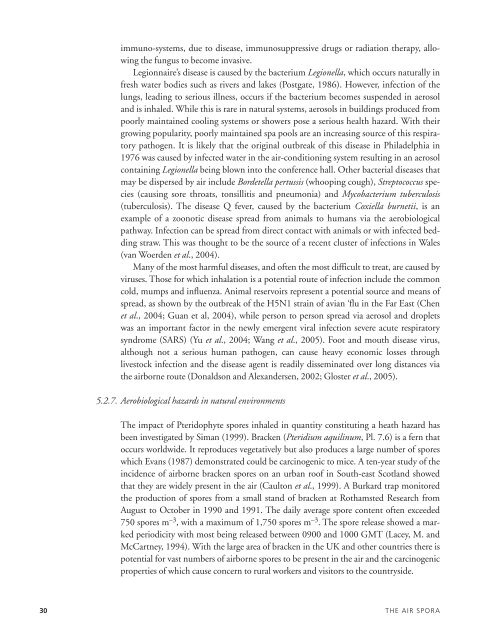
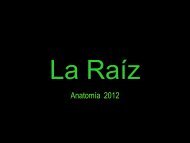



![Estructuras secretoras internas [4.64 MB]](https://img.yumpu.com/14294979/1/190x143/estructuras-secretoras-internas-464-mb.jpg?quality=85)
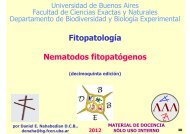
![anatomía y exomorfología [7.14 MB]](https://img.yumpu.com/12744163/1/190x143/anatomia-y-exomorfologia-714-mb.jpg?quality=85)
